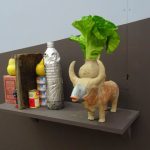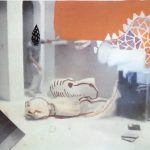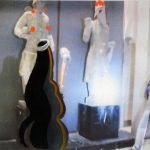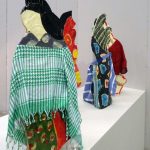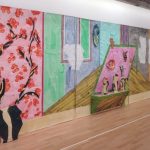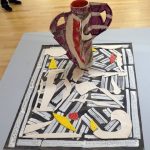“Things happen, and then they happen again, but not the same way, not quite; such is the logic of the biennial. And then there are things which have never happened before, and which happen now and in a time that seems somehow out of time, or takes our “now” out with it.” [hints]“Dingen gebeuren, en dan gebeuren ze weer, maar niet op dezelfde manier, niet helemaal; dat is de logica van de biënnale. En dan zijn er dingen die nooit eerder gebeurd zijn, en die toevallig nu gebeuren en in een tijd die op een of andere manier uit de tijd lijkt, of die ons “nu” er buiten plaatsen.”[/hints]
Dit schreef recensent Jeremy Millar[hints]Millar is – naast kunstenaar – docent ‘Critical writing in Art and Design’ aan de Royal College of Art in Londen. Toen ik kort na de preview even op internet zocht naar recensies van de Liverpool Biënnale 2016, was zijn stuk ‘all over the place’. Als recensent is hij in ieder geval goed toegerust om snel internet presentie op te bouwen met een tekst van zijn hand.[/hints] over de Liverpool Biënnale 2016. Ik vond het mooie formulering, en daarom citeer ik hem hier graag. Als ‘Europese’ bezoeker merkte ik, net als Millar, dat alles op dit zeer internationale kunstevenement nog nabeefde van Brexit. Alle officiële praatjes bij de opening, twee weken na het referendum gaven er wel even aandacht aan, zonder te benadrukken dat de bevolking van Liverpool (circa 465.500 inw.) met zo’n 58.2% voor ‘in de EU-blijven’ had gestemd.
Hoewel nog altijd onduidelijk is wat met die uitkomst van het raadplegend referendum gaat gebeuren, beïnvloedt dat toch ook de blik waar mee ik naar Liverpool zelf en naar deze Biënnale kijk.
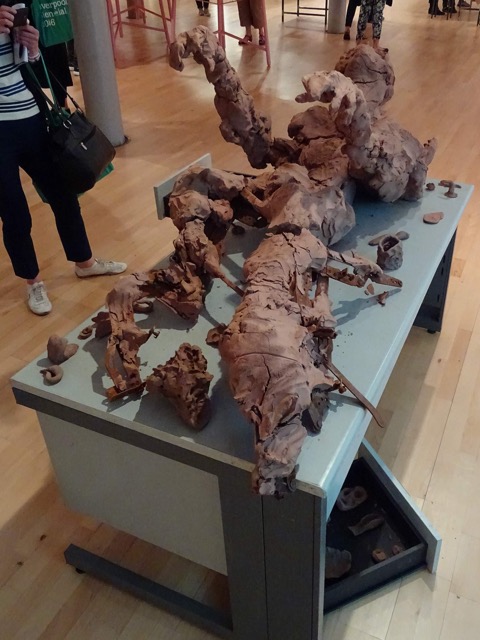
Verwoesting
Ik zie een versplinterende wereld voor me. Ondanks de miljoenensteun van de Europese Gemeenschap voor herontwikkeling zie ik nog altijd een lelijke, gehavende stad. Een stad die de ‘kaltstellung’ door Margaret Thatcher voor zijn opstandige rol tegen haar beleid nog altijd niet te boven lijkt gekomen. Ook een stad waarop tijdens de Tweede Wereldoorlog de Duitse Luftwaffe in totaal 80 bombardementen heeft uitgevoerd, waardoor 50% van de stad verwoest werd zo’n 2.500 inwoners het leven lieten. Dat heeft zo ingegrepen in de structuur van de stad, dat deze nog altijd blijkt te zijn verscheurd. De huidige architectuur is een snoeiharde confrontatie tussen wat ooit was en wat ervan moet komen. Ogenschijnlijk zonder gevoel voor richting.
Slavenhandel
In het begin van de 18e eeuw ging veertig procent van de wereldhandel via de haven van Liverpool. Liverpudlian reders waren tussen 1740 en 1840 verantwoordelijk voor mogelijk wel 80% van de door de Britten uitgevoerde slavenhandel. Dat maakte de reders uit Liverpool tot de grote spelers van de trans-Atlantische slavenhandel. Vanuit Liverpool zijn meer dan 5.300 trans-atlantische vaarten uitgevoerd en meer dan 1,5 miljoen slaven op de zogenoemde ‘triangel vaarroute’ verplaatst van West Afrika naar de Cariben en de Amerika’s. Circa 20 tot 25% van de zo getransporteerde slaven kwam al te overlijden voordat ze hun bestemming bereikten.
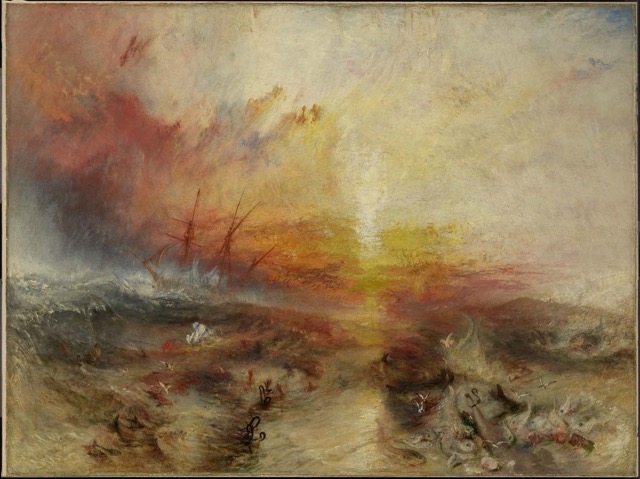
Neoclassicistische Bouwkunst
De slavenhandel was in mijn ogen een gruwel van een donkere periode, die desondanks grote welstand naar Liverpool heeft gebracht. Dat leidde vervolgens weer tot een bouwwoede in Neoclassicistische architectuur die het Griekse en Romeinse voorbeeld naar de kroon moest steken. Liverpool als een tweede versie van het Oude Griekenland of de oude stadstaat Carthago. Ondanks de vernietigende bombardementen in de Tweede Wereldoorlog zijn ook hiervan nog tal van overblijfselen in de stad te vinden.
Slavernijmuseum en Beatles
Op 23 augustus 2007 opende in Liverpool – ter gelegenheid van de Slavernij Herdenking, het Slavernijmuseum juist hier zijn deuren. Het is een poging op meer openheid te scheppen over die duistere, gitzwarte tijd in de achttiende eeuw. Die dag was het tweehonderd jaar geleden dat de slavenhandel in Groot-Brittannië werd afgeschaft en ironisch genoeg was het ook de 800ste verjaardag van Liverpool zelf. Het jaar daarop was Liverpool Culturele Hoofdstad van Europa, samen met Luxemburg. Naast al dit was Liverpool in de jaren zestig natuurlijk het centrum was van de ‘Mersey Beat’: ‘alle Beatles zijn in Liverpool geboren’.
Met deze inleiding begrijp je misschien beter, waarom ik de opening van Jeremy Millar zo treffend vind als we het over onze tijd, het ‘nu’ en Liverpool hebben. En natuurlijk over die Biënnale.
3×3 Tinten Storytelling
Thematisch is het niet eenvoudig richting te vinden in de 9e editie van de Liverpool Biënnale. De kunstmanifestatie mist een enkelvoudige titel of één samenhangend thema. Er is een structuur van zes op zichzelf staande ‘afleveringen’. Die zijn mogelijk allemaal nodig om de verhalen (we hebben het natuurlijk over storytelling) mogelijk te maken. Bovendien moest een een zeer divers peloton aan kunstenaars ondergebracht worden: 37 kunstenaars, duo’s en collectieven, verspreid over 26 locaties.
In de woorden van Biënnaledirecteur Sally Tallant worden ‘fictie, verhalen, en geschiedenissen onderzocht, die de bezoeker meenemen op een aantal reizen door ruimte en tijd, met betrekking tot Liverpools verleden, heden en toekomst.’ Een elf leden tellend team van curatoren heeft dit dus vertaald naar een indeling in 6 ‘episodes’; het oude Griekenland, Chinatown, Kinderen, Software, ‘Monumenten voor de Toekomst’ en Flashback.
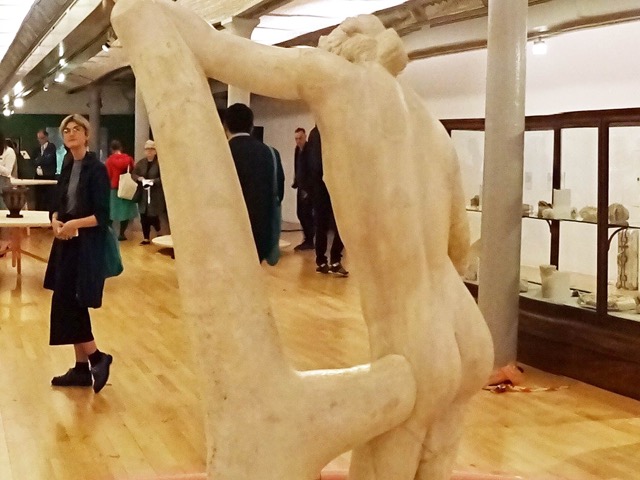
Grabbelton
Hoewel ik de keuze voor aan plekken verbonden verhalen sympathiek vind, is die keuze ook weinig origineel. Voeg je daar ook nog eens 6 ‘episodes’ aan toe wordt het zo breed dat het weer zinloos lijkt. Immers: bestaat er wel een plek zonder verhaal of zonder geschiedenis?
Om alles nog verwarrender te maken, lopen de verschillende ‘hoofdstukken’ of ‘afleveringen’ door de verschillende locaties door elkaar heen. Daarbij lijken ze elkaar soms te versterken maar soms ook tegen te werken. Tijdens de bezichtiging ervoer ik het als een zinloze oefening die, in plaats van verhelderend, versluierend en verwarrend werkt. Dit komt ook omdat de werken van de betrokken kunstenaars zich niet eenduidig lijken te voegen naar deze fragmenterende indeling. Wonderwel blijkt dan dat de samengebrachte werken of alleen of samen hun eigen verhaal vertellen, maar het gevoel van een grabbelton die af en toe tot verwondering leidt blijft hangen.
Cains Brewery
Het sterkst ervoer ik dit in de grote hal van de voormalige Cains Brewery. Deze met rijke historie behangen plek waarvan het voorgebouw met allure is opgetrokken uit rode baksteen, heeft aan de achterzijde een zielloos moderne industriële hal. In deze sjofele hal is een structuur opgericht als een nieuw tentoonstellingsgebouw met de naam ‘Collider’ van de hand van Andreas Angelidakis. Deze polygonale structuur heeft in het centrum een cirkelvormige arena. ‘Collider’ verwijst naar de deeltjesversneller bij Genève (CERN in Zwitserland). Er zijn in en om dit object weer ander structuren gebouwd. Aan de wanden, in het centrale middendeel, in de hal er omheen is ‘her en der’ werk van verschillende kunstenaars opgesteld. Soms verbinden die objecten en werken zich met de door Angelidakis opgezette structuur, soms lijken ze die structuur te ontkennen en als hinderlijk te ervaren.
Kunstenaars die hier een plaatsje hebben gevonden, zijn dan weer afkomstig uit de verschillende ‘episodes’. “Weet u het, weet ik het”, zou ik bijna willen verzuchten. Het is een wankel en rommelig geheel met werken van Céline Condorelli, het trio Ramin Haerizadeh, Rokni Haerizadeh and Hesam Rahmanian (zowel objecten als videowerk), Audrey Cottin (Flourtables), Ian Cheng (Emissary Forks For You), Lara Favaretto’s (Lost and Found suitcases), Rita McBride (objecten Perfiles), Jason Dodge (What the Living Do), Samson Kambalu (video) , Yin-Ju Chen (Extrastellar Evaluations), Marvin Grays Chetwynd (met kinderen uitgewerkte film Dogsy Ma Bone, geïnspireerd op een liedje van Betty Boop, A Song A Day uit 1936). Vervolgens is er nog een werk te vinden van Betty Woodman (Kinmono Ladies – ceramiek en textiel) en Sahej Rahal.
Tate Liverpool
Tegenover de opstelling in Cains Brewery is er de tentoonstelling in Tate Liverpool. Daar is ook het informatiecentrum van de biënnale gevestigd en daarmee zie ik de Tate Liverpool ook als startpunt voor bezoekers. De tentoonstelling hier op de eerste etage is onderdeel van de episode “Oud Griekenland”.
Hier zijn de oudheidkundige collectie van het Nationaal Liverpool museum, de archeologische antieke collectie van Ince Blundell met werken van hedendaagse kunstenaars samengebracht. Hier is de presentatievorm museaal van karakter, en ondanks de vermenging blijft de expositie daardoor overzichtelijk. Hier is het gelukt om een atmosfeer te scheppen waarin de werken elkaar bevragen, aanvullen of versterken.
Het gefragmenteerde aspect van de door de curators gekozen formule werkt hier impliciet of ‘inclusive’. De oudheden uit ‘Ince Blundell Collection’, zijn veelal fragmenten van beelden of sculpturen die zelf weer samengesteld zijn uit diverse fragmenten. Daardoor ogen ze bijna postmodern. De dreigende verbrokkeling vormt een brug naar de getoonde hedendaagse werken. Deze werken zijn van de kunstenaars: Koenraad Dedobbeleer (display structuren), Andreas Angelidakis (video), Jumans Manna (video), Betty Woodman (mural piece), Lawrence Abu Hamdan (video Double Take), Jason Dodge, Samson Kambalu en Sahej Rahal.
What the Living Do
Jason Dodge’s ‘What the Living Do’, verspreidt zich over de gehele biënnale, en bestaat uit verzamelde fragmenten, kleingruttige rommel die mensen achteloos achterlaten: snoeppapier, peuken, verbruikte treinkaartjes, notitiepapiertjes, lege mini-drankflesjes, verpakkingen van tussendoortjes, afgevallen bladeren en schelpen.

Op andere plaatsen schuurt dit minder dan hier op de vloer van de tentoonstellingszaal, waar dit werk iets toevoegt aan de algehele fragmentering. De snippers en rommel onderscheiden zich net van de ‘echte’ zooi in de stedelijke ruimte, die je gaandeweg hebt geleerd te negeren. Hier komt die het museum binnen als een onvermijdelijke tsunami. Geen ander werk is zo op zijn plaats in deze biënnale als dat van Jason Dodge.
Betty Woodman
Tegenover het out-of-control-achtige en fragmenterende werk in deze biënnale staat Betty Woodman (1930). Zij maakt uiterst afgewogen werk dat ze opbouwt uit tweedimensionaal schilderwerk, keramische platen en driedimensionale objecten. Deze kunstenaar, een grande dame wier kunstenaarscarrière een aanvang nam in 1950 en die dus een werkzame periode van meer dan 65 jaar in zich mee draagt, is voor mij de verdwaalde ster in dit wat brokkelig geheel.
Zeker gaan kijken
De Liverpool Biënnale 2016 is een omvangrijk kunstproject. Dat doe je er zeker niet even in een dag bij. Het is een goed excuus, met alle hernieuwde belangstelling voor de ‘Britains’, om een uitstapje te maken naar Liverpool. Combineer het met je andere hobby’s. Was je al fan John, Paul, Ringo en George, maar is het er nooit van gekomen? Doe het nu en ontdek de stad van de Mersey Beat, met zijn verhalen en geschiedenissen!
Naast het hoofdprogramma van de biënnale met zijn buiten- en binnen locaties (26), zijn er partnertentoonstellingen zoals o.a. de ‘John Moores Painting Prize 2016’ in de Walker Art Gallery (Een zeer respectabele prijs voor schilderkunst die al bestaat vanaf 1957) en de even respectabele ‘Bloomberg New Contemporaries 2016’ die 46 jonge kunstenaars een podium biedt in Bluecoat. Een vol programma met tours, talks, workshops, films, performances, conferencies en symposia’s. Alles het bezoeken waard tot 16 oktober 2016.
